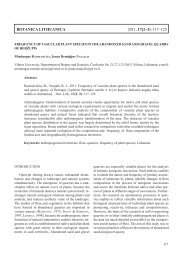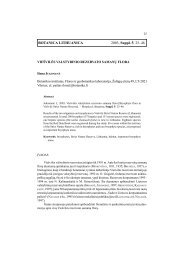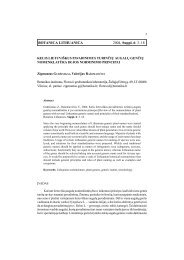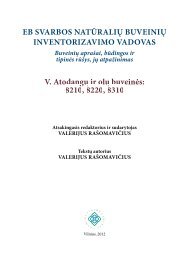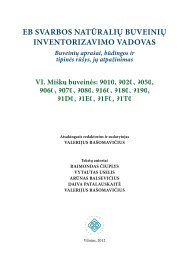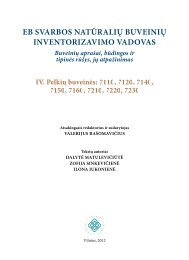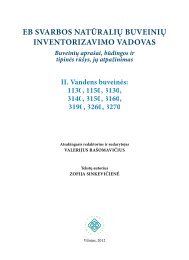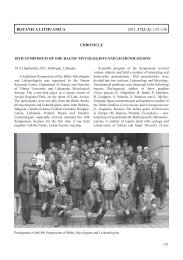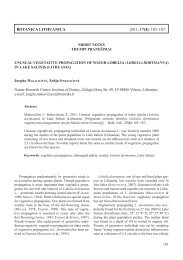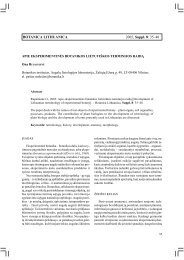FUNGI AND LICHENS IN THE BALTICS AND BEYOND XVIII ...
FUNGI AND LICHENS IN THE BALTICS AND BEYOND XVIII ...
FUNGI AND LICHENS IN THE BALTICS AND BEYOND XVIII ...
Create successful ePaper yourself
Turn your PDF publications into a flip-book with our unique Google optimized e-Paper software.
2007-2009 in 25 m radius sample plots. Totally were evaluated 100 plots. Forest stand<br />
parameters, dead-wood and species of fungi were evaluated in each plot. Only old-growth<br />
indicator species were taken into account.<br />
Totally 27 species of fungi were discovered. The most common species were<br />
Xylobolus frustulatus (105 occurences), Fomitopsis rosea (46) and Clavicorone pyxidata (30).<br />
Meanwhile 5 species were recorded only once. Among the most interesting species for the<br />
region can be mentioned Piptoporus quercinus and Hapalopilus salmonicolor.<br />
The most important tree species for the rare wood-inhabiting fungi were determined being<br />
Quercus robur, Picea abies and Populus tremula. The highest species richness of fungi was<br />
registered on Picea wood, followed by Populus and Quercus. Meanwhile biggest abundance<br />
was detected on Quercus, followed by Picea and Populus. Coarse dead wood of medium<br />
decay stages proved to be most important substratum for rare fungi.<br />
Significant difference in rare species diversity and abundance was found<br />
between long-time untouched and managed forests.<br />
MONITOR<strong>IN</strong>G OF FUNGAL DISEASES <strong>IN</strong> STRAWBERRY COMMERCIAL<br />
FIELDS <strong>IN</strong> LATVIA<br />
R. RANCANE, L. VILKA, J. VOLKOVA*, M.EIHE, A. BAZHENOVA<br />
Latvian Plant Protection Research Centre, Struktoru Str. 14a, LV-1039 Riga, Latvia<br />
*E-mail: julija.volkova@laapc.lv<br />
The diversity of strawberry fungal pathogens and their distribution in commercial<br />
fields in Latvia has been investigated since 2007. Ecological, climatic and agricultural factors<br />
cause changes in the distribution of fungal diseases, and their importance.<br />
The first observation was done in 2007, when 31 commercial strawberry plantations<br />
were surveyed in all territory of Latvia. Samples of damaged leaves and rotted berries were<br />
collected during survey. From the leaves and berries fungi were isolated directly on the<br />
isolation plates and identified by comparing morphological characteristics from descriptions<br />
in the literature. Further observations were carried out in the following years. During the<br />
monitoring in 2007, from berries mainly traditional pathogen Botrytis cinerea was isolated; it<br />
was found in all observed fields. Also secondary fungi – Mucor spp., Rhizopus spp. and<br />
Fusarium spp. were observed frequently. Other isolated pathogens: Hainesia lythri, Idriella<br />
lunata and Coniella castaneicola were found in a few samples. Phomopsis obscurans was<br />
isolated just in one sample in 2007, but in the later observations it was observed more<br />
frequently from leaves and berries, especially from the fields with imported planting material.<br />
Plants of strawberry’s variety ‘Sonata’ were often infected with Phomopsis obscurans. In<br />
2007 powdery mildew caused by Sphaerotheca macularis was observed only in Kurzeme<br />
region which is located more to South, South-West part of Latvia, but in further observations<br />
in 2010 and 2011 powdery mildew was observed also in Central and Northern regions of<br />
Latvia, especially on susceptible varieties, such as ‘Zephyr’, ‘Kent’, ‘Petrina’. Some damages<br />
related to different Phytophtora species were observed in fields in 2011 but further<br />
investigations and observations are necessary.



